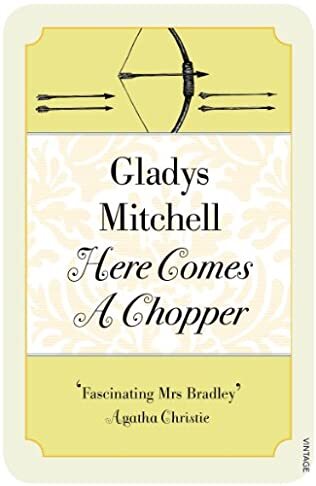Here Comes A Chopper

A review of Here Comes A Chopper by Gladys Mitchell
For those readers who like to follow the development of an author and their characters by reading their works in chronological order, there are some frustratingly large lacunae in the readily available books of Gladys Mitchell. Here Comes A Chopper, the nineteenth in Gladys Mitchell’s Mrs Bradley series, originally published in 1946, is the next book after Laurels are Poison (the 14th) that I could find in e-book format. Reading Mitchell’s Mrs Bradley series is not for the faint hearted but for a writer who is supposed to be a doyenne among crime writers, this seems a lamentable set of circumstances.
This is one of Mitchell’s more readable and accessible books. It almost seems that its lightness of spirit is a direct response to the end of the Second World War. However, it would not be a Mrs Bradley story without a dash of the weird, in this case two headless corpses and a novel place to hide a head in, some psychology – after all, Mrs Bradley is both an amateur sleuth and an acclaimed psychoanalyst – some mythology, and a narrative full of quotations from obscure poets. As an aside, as someone who is now almost dependent upon search engines to look things up, I am constantly in awe at the depth and breadth of Mitchell’s knowledge.
The title of the book comes from a line in the nursery rhyme, Oranges and Lemons, but also, clearly, a reference to the severing of the victim’s head. In essence, though, this is a country house murder mystery, and, by Mitchell’s standards, a fairly conventional one at that. The book opens with a schoolmaster and poet, Roger Hoskyn, looking forward to meeting up with his friend, Bob Woodcote, and going for a ramble in the countryside. However, Bob has injured his ankle and his sister, Dorothy, meets up with Roger to give her brother’s excuses – no mobile phones in those days – and agrees to be Bob’s substitute.
They get lost and stumble across a country house where they stop to ask for directions. They are astonished to be invited in to dinner, as the master of the house, Mr Lingfield, has gone missing and the hostess will not entertain the prospect of sitting down to a table of thirteen. After leaving the house and enduring a train journey on a branch line, they are picked up by Lingfield’s chauffeur, Sims, to take them home, although home turns out to be Mr Lingfield’s mansion. One of the house guests, inevitably, is Mrs Bradley.
The following day Lingfield’s body is found, naked and decapitated, but is it Lingfield and what happened to him and who committed the crime? Where is the head? Mrs Bradley sets out to investigate. There are red herrings, scars, assaults on poor Roger, some archery, a closed set of suspects, some eccentric and others hiding their emotions and jealousies, and a bewildering array of clues and hints which eventually lead to the resolution of the mystery.
There is a distinctly heavy dose of romance running through the tale. Roger, as befits a young man who has been educated and works in an all-male environment, is hopeless with women and seems to fall head over heels with any woman he falls in love with, first Dorothy, then the book’s femme fatale, Claudia Denbies, to whom there is more than meets the eye, and then Dorothy once more. Mitchell is an acute observer of the behaviour of those who fall in love and the ups and downs of nascent relationships.
It is a book full of humour, especially over the identification of a body that is both headless and naked, sharp observations, and, with Mrs Bradley on top saurian form with a mischievous glint in her eye, it is one I would recommend to someone looking to discover what Gladys Mitchell is all about.



